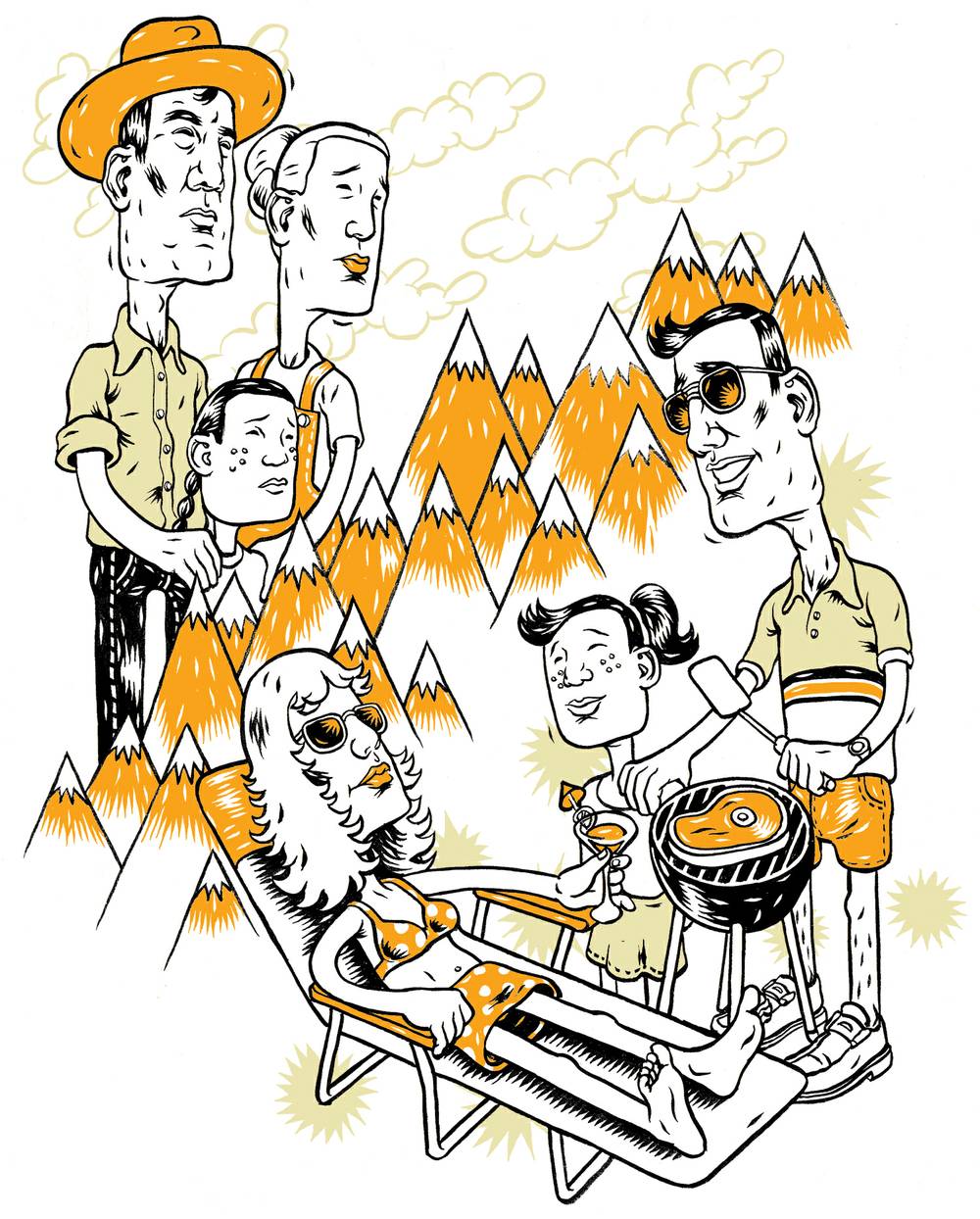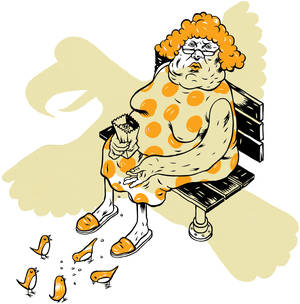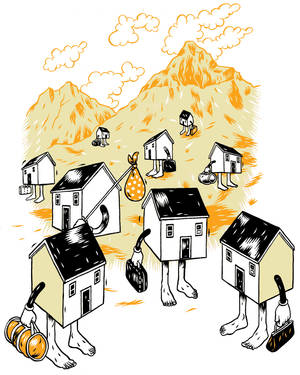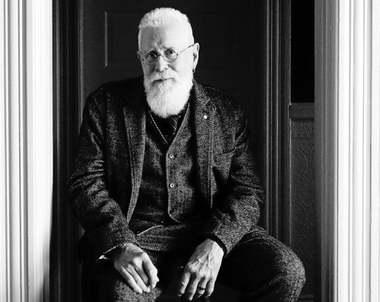Death of the Neon Dream Machine
I shouldn’t be surprised that since I’ve been gone, everyone I know in Vegas has developed an interest in economics. A year ago, my friend Leo moved here from Pahrump with her husband, Cody, after their daughter Kiley was born. Leo and I grew up in Pahrump, on the other side of the Spring Mountains—over the hump, as they say. Pahrump is best known as a Vegas-adjacent tract where the fireworks are cheap and the whorehouses are taxpaying, government-regulated establishments. Aside from sex work, Pahrump’s economy is built upon two cornerstones: ubiquitous poorly ventilated Old West-themed casinos and a Walmart, the township’s treasured, fluorescent-gleaming hub. Opportunity-wise, it is a place where the men work construction and the women serve cocktails and get pregnant too soon. Leo moved to Vegas because she wanted to go to college, wanted something better than waiting tables at the Saddle West. Hers was the hopeful migration of all rural folk escaping the death-grip of a small town, looking to cash in on the betterment promised by the plain fact of the city, myself included.
But, like so many symbols of a new and glorious life, Las Vegas has not held up its end of the upward-mobility narrative. Cody was laid off in April when the city’s omnipresent, ant-like construction industry imploded, and he’s been caught in a blue-collar clusterfuck ever since. Without work he hasn’t been able to log hours toward his journeyman’s card; without the card he has been unable to find work. The jobs he has been offered pay less than unemployment. Leo found a job hanging fliers on doorknobs in new subdivisions. They live in a mobile home in a part of town where the billboards advertise bail bondsmen and paternity tests and opportunities to masturbate on-camera. Her neighbors celebrated New Year’s by firing their guns in the air.
Leo says maybe the neighborhood “isn’t the best” and even admits that it sometimes makes her afraid, but mostly she doesn’t want her daughter to grow up here. She says what truly scares her is being alone out in the nice developments, the creepy desolation of newly minted suburban sprawl. “Every other house has a sign posted,” she says. “Bankruptcy, foreclosure, some of them never even lived in.” I imagine her parking her van and walking with her bright, tow-headed daughter through yards overgrown with cheatgrass and waist-high smotherweed, slipping gloss ads into the mail slots of empty houses, walking along the unmarked sidewalks through miles of deserted cul-de-sacs. This, I think, is the source of dread among Las Vegas’ out-of-work working class: If the city has begun to cannibalize the middle class, its pit bosses and its superintendents and its middle managers, to devour even the wholesome and the buoyant, we who were already its foodstuff don’t stand a chance.
When I ask Leo about the economy she says some parts of the city are already gone. She says the banks should take what they can get. Maybe that’s what she’s done. Maybe it all comes down to that.
At night you can look east from Pahrump and see the lights of Las Vegas glowing over Mt. Charleston. If you look long and hard enough, that city shine seems to wobble and dance, the aurora borealis of the Mojave, the electric pulse of opportunity. I wonder if Leo ever watched the lights like that. Was she comforted to know there was something out there, something bigger than her, that it was just over the mountains and that it would always be there? I was. I wonder if she ever thought, My real life starts out there. Was that impulse like voltage to her, like a current zipping through her blood? And if it was, what now?
Leo and Cody live in the city we all grew up dreaming about. There is a certain energy in that, or there was. Still, they seem determined to cultivate something resembling happiness. Cody puts in new applications every week. Leo makes a little money cleaning houses and manages to take classes at International Academy of Design & Technology. She has become an expert in making do. Inside, their house is comfortable and clean and domestic in that distinctly pre-fab Vegas way, a manufactured home in the best sense of that euphemism. The day I visit she shows off an Ikea rug that she found at a garage sale and fixes me a tender hunk of the best pot roast I’ve ever had. Their life has its subtle, specific joys: the whir of central air, a California King. At night Kiley inevitably wanders into their room and climbs up onto that prairie of a bed. I can see the three of them sleeping happily there with their limbs intertwined, the sheets cool against their skin, their breath deep and even. I can see them getting by.
Of Opiates and Ornithology
My aunt mo has lived off Washington Avenue her whole life. Since I was a kid her favorite gag has been a morsel of old-fashioned wordplay. She would shake a hand and lean in and ask earnestly, “How are you enjoying your stay here in Lost Wages?” Back then destitution was a trick played on the tourists, a harmless (or at least temporary) inside joke. When I visit today she does her Lost Wages bit only once, and there is no trace of that long-ago mischief. It sounds like a sad prophecy that came true.
Vegas is changing, she says, and it’s not just the economy. The weather is different, the air is heavier. New plants and animals are moving in. As the only home she’s ever known crumbles around her, my aunt’s anxiety is made flesh in invasive species. She says Vegas has bedbugs now, that the Strip is infested with them. Indeed, I learn that while bedbugs were all but eradicated from the U.S. by 1960, they’re back—thanks to globalization and the outlawing of DDT, that biomagnifying carcinogenic wonderspray—and the blight has hit Lost Wages. In April, the Tropicana offered to pay its housekeepers for finding bedbugs, $25 for one of the wingless, apple seed-sized bloodsuckers. Bedbugs make nests in mattresses, and these nests give off a thick, moldy-sweet odor and I wonder if the housekeeping staff at the Trop was trained to detect that smell. Aunt Mo says that foreigners brought the bugs and that she can feel them on her sometimes, their slender suckling mouthparts probing her skin in the night.
Mo says the swamp cooler she’s relied on for 26 years doesn’t work anymore because the air has become too humid, a curse word in these parts. Humidity has rotted her roof, she says, and every day the dead weight of the cooler sinks further into the spongy shingles. She says her house is so infested with termites that she can practically hear them worming through the wood. I believe her when she says termites have never been a problem in the desert, mostly because I grew up thinking they were make-believe. “The insurance companies won’t touch the place,” she says. “They run away screaming.”
For Mo, the stagnant panic hanging over Las Vegas is best personified by alien megafauna. “Used to be all we had were sparrows,” she says. “Now we got these big honkin’ things. They don’t even know what they are.” This can’t be true—that a new, unidentified bird species has taken up residence in the skies over the Entertainment Capital of the World. The birds would be the animal kingdom’s most impressive adaptors to the destructive presence of man, next to the bedbug. My boyfriend is a student of wildlife biology at Ohio State and works as a naturalist in the parks system. He confirms it quietly. “I love her,” he whispers, “but your Aunt Mo is full of shit. If there was an unclassified species of bird in Southern Nevada we’d move here and I’d write my dissertation on them.”
Not only is my Aunt Mo endearingly full of shit, but she also has a history of helping herself to a varied assortment of prescription narcotics, mainly morphine and OxyContin. She’s supposed to be clean—this is one of the conditions of my visit—but I can’t tell if she is. I never could. She’s definitely loopy, but she’s a loopy person. Then again, I haven’t seen her sober since I was about 14 years old. I don’t know what kind of person she is anymore.
Aunt Mo goes on, telling me about these giant birds they have now—the golden shimmer in their feathers, the sharp hook of their beaks—and I find myself aching with the familiar hope that this is really her, and that I might spot one of these dark, unidentified birds of prey circling the AmPm on Decatur. Though I have enough experience with eccentric addicts to know better, I want the birds to be real. I want this near-ruined valley to be capable of sustaining life.
I have a shameful tendency to use books and my education like weapons against my loved ones and there is a part of me that wants to destroy my aunt’s imaginary birds like this, use 101-isms and what I remember from Intro to Environmental Science to eradicate them from the only place they ever existed. But I try to remember all the ways in which her life has obliged this fretful displacement. Crohn’s disease has disintegrated her digestive tract, and her body has given way to an onslaught of harsh steroids, chronic pain, fatigue, obesity, hair loss, diabetes and the abuse of tremendous amounts of methadone, codeine and the other aforementioned hardcore opiates. Meanwhile, her heart has succumbed to depression, unemployment, poverty and the death or distance of nearly everyone she ever loved. It’s no wonder she longs for a time when she didn’t rely on food stamps and a stoma bag hanging from her abdomen, when her bowels worked and her appetite was strong and her brother and sister were still alive, when the air was bone dry and filled only with sparrows and the cottonwoods glistened with pesticide. There is nothing honorable or intellectual in holding the wounded accountable for the way their mind copes with such potent strains of fear and loneliness.
And perhaps there is a poignancy embodied by my aunt’s winged ill omens: a bead of fearsome sincerity among the superficial, a blossom of nostalgia in a city where the buildings are built in order to be torn down. Meanwhile, we all have our talismans against disaster and despair. We have our homeowner’s insurance, our union pensions, or lacking even those, we have our OxyContin, our DDT, our liberal arts educations. Allow us these.
The First Church of God in the Wilderness
I’ve been in Las Vegas for a little under three hours and I can’t escape the feeling that the city is dying. It’s 104 degrees and I’m in the passenger seat of my stepfather’s 1988 Mercedes two-seater with no air conditioning, hurtling down I-15. My stepfather, Ron, stays cool with a vat-like Double Gulp of ice-cold Mountain Dew wedged between his legs, and mysterious desert adaptations I once had but have since lost. I’ve been away for two years and as we zip down the length of freeway parallel to the Strip, I don’t recognize half the buildings. Some of the hotels I do recognize are now plastered with 10-story posters for their parent companies’ wannabe summer blockbusters and their own gimmicky shows. I’m sure these new ads were conceived by some out-of-the-box marketing type as a lucrative new mechanism in the Strip’s over-stimulating spend spend machine, but in these dark times they emit only neediness and desperation among the gaming giants, price tags at a citywide going-out-of-business sale.
Ron points out half-finished mega-casinos with Italian names stylishly scribed on them, their concrete skeletons exposed. Shells of two glassy gaping towers rise from the dirt and twist into each other in the way of a DNA double helix. My stepfather is a construction worker, a builder of these marvels. Or rather, he used to be. Though he is too proud and mulish to admit the actual numbers to me, I estimate that he worked six to 10 weeks out of the last year. He would never say as much, but he is a casualty of the economic shitstorm that has rained down upon Vegas. In the car, he tells me that some Strip casinos will “go up hollow,” only their exteriors completed as facades. No rooms inside, no plumbing, no walls. He tells me they’ll erect the insides when the money comes back, when people start buying time shares and booking rooms again, though no one knows when that will happen. He points silently to two cranes unmoving and abandoned on their rooftops. The Nevada state bird, he would have joked in better times.
Driving amongst the guts of these construction projects I am starting to realize something shameful and solipsistic about myself: I am glad they’ve failed. This is an ugly and inconsiderate sentiment; I am aware of this. Nonetheless, a part of me has come to think of the economic crisis and subsequent halt of the city’s outward march of development as a victory. How large a part I’d rather not say.
As a desert rat, I find myself ethically at odds with so-called development, the construction industry and—by an understandable loyalty to his long-time employers—my stepfather. Ron is openly hostile to even the slightest hint of environmentalism. He disdains even my scuffed-up neon-green Nalgene and throughout my entire visit he presses “fresh” bottles of water into my hands.
This is nothing new; one could book the colossal Las Vegas Convention Center and fill all 3.2 million square feet of it with green-leaning hipsters and the conservative fathers who disagree with their politics. But from here, hovering up above the subdivisions, it occurs to me that our dynamic is also the very same that frustrates conservation efforts throughout the country and the world: the tension between the local and out-of-towner, the colonized and the colonizer.
I live in Ohio now, which, as far as most Nevadans are concerned, is a nondescript no-man’s land somewhere in the Midwest. Friends and family often ask how I like living in Iowa. I tell them I like it all right because from here, Ohio might as well be Iowa. But Ron is indigenous by even this place’s steep standards. His father was stationed at Nellis. He grew up here, went to Rancho and—after raising us kids out in the sticks—returned to Las Vegas as soon as prodigally possible. He cashes his paychecks at Sam’s Town, chain-smokes Camel nonfilters and plays convenience-store slots, though he denies this. He lives on Roy Rogers Drive and votes Libertarian. He is a local in a city besieged by tourists, in a state invaded by California transplants and other carpetbaggers, myself included. That authority is hard to dispute.
For example, when I criticize the unsustainable use of water resources needed to maintain the city’s verdant golf courses, he says that water doesn’t count toward waste because it’s graywater, which he knows from overseeing the expansion of a water-treatment facility a couple years ago. That’s great, I say, but wouldn’t it be even better if the city’s 1.8 million residents could use graywater, too? He rolls his eyes. I ask him if he actually believes that by using recycled water on some city parks and golf courses we’ve solved the Southwest’s water crisis. He nods curtly. “Yep,” he says. “Trust me. I built the shit factory.”
Later, I mention an article I read on the plane about living green roofs. Because National Geographic always leaves me flush with optimism, I suggest that green roofs could improve air quality here, curb urban flash flooding and mitigate the intense heat-island effect that is right now making this city straight-up unbearable. I share my visions of casinos and strip malls and otherwise soul-sapping apartment complexes topped with runoff-absorbing, toxin-filtering soil sprouting saguaros and sagebrush, hearty grapevines and tufts of deer grass. Ron scoffs. “Have you ever been on a Vegas roof in August?” he asks. “It’s 160 up there and you want to plant a vegetable garden.” What can a tourist say to that?
It’s undeniable that when the decision comes down to, as my stepfather sees it, feed your family or save a tree, conservation doesn’t stand a chance. This is a reiteration of the same no-brainer presented to soy farmers in the Amazon rainforest or Kenyan cattlemen whose herds are thinned by endangered wild dogs. I get that. But isn’t there something especially repulsive about suburban sprawl that the gods of industry and commerce have forsaken? And yet, my stepfather—and he is in good company in this city, I believe—considers his lifestyle a God-given inalienable right. He acts as if acres of brave young Americans gave their lives so that the rest of us might drive SUVs and blast the A/C with our front doors wide open. (A scary thought: In the post-W era, this sentiment might not be far off.) Still, what kind of acrobatics of logic have us mourning the death of slash-and-burn development and hot-selling master-planned communities while the ideology them made it possible—fetishized growth and consumerism, unfettered capitalism and the massive-scale consumption of resources—basically shit in our collective hat?
Reader, by now you’ve likely guessed that I feel more connected to the desert badlands outside Las Vegas than to the city itself. What I love most about this place is the negative space surrounding it, the creosote flats sloping up into alluvial fans, the spiny yucca and sage, the junipers and pinion pines. My family always lived somewhere out in the remote windswept valleys to the west, so my parents had to drive us here for groceries, clothes, office supplies, tools, just about anything a family needed to survive. It was a long drive made longer by being a kid, but I looked forward to the descent into the Las Vegas Valley and its subtle procession of natural curiosities: spotting herds of wild mustangs charging across the wide creosote flats outside Blue Diamond, my mother pulling over to carry a desert tortoise safely across the highway. Once, from the backseat of our truck, I caught a glimpse of a desert bighorn sheep near the summit of Spring Mountain Pass. It was standing atop a high rock outcropping that overlooked the canyon, a spot where I always checked for bighorns because it was epic and I envisioned it as the place where the Nevada state animal would stand, should stand. Since then, that particular sheep has melded with all iconic images of bighorns: full-breasted and majestic, golden-eyed, thick, rootish horns curling back from a shrewd face. What I do recall is feeling rewarded by the sighting, as if my looking prayer-like to that outcropping had been an act of faith and the bighorn itself a message of thanks from a rustic god, the landscape’s way of saying, ask and ye shall receive.
As a gesture of goodwill, I offer to take Ron to a movie and he agrees. That night, we meet my sisters and cousin at Red Rock, a newish Station casino whose every design element and architectural motif—the strata-patterned carpet, the rust-colored leather upholstery, a pair of fiery paintings flanking the lobby, sandstone signage inside and out—evoke the very same terrain desecrated by their construction. Here, guests are offered “adventure packages” where, for $450, they get a two-night stay and a massage after biking through Red Rock Canyon, because it’s right there. After three hours inside I become convinced the entire expansive property was erected as some post-modern joke. Or perhaps as an elaborate shrine to the wilderness that died for its sins.
If the wilderness be blessed, there is perhaps nowhere in the Las Vegas Valley more sacred than Red Rock Canyon. When I was a girl my grandma Mary Lou told me how that vein of flamboyant red rock surfaced in only two places on Earth. Here, she said, and on the other side of the world, in the Holy Land. Never mind world geography, ancient thrust faults, similarly oxidized formations as close as Utah. And forget the fact that the Earth’s outer core is probably composed of a swiftly spinning liquid: You need only visit Red Rock in the early morning while the air is still violet with night to see a truth in this.
On our drive home from the casino the sun is setting over those blood-red, encroached-upon cliffs. We navigate the lanes and girders of development homeward, the endless fields of Summerlin rolling out from us like an ocean, and I feel a familiar bleakness welling inside me. Is this what we paved our yucca forests for, a manicured wasteland of rapidly evaporating swimming pools and sun-bleached stucco and Spanish tile roofs, vapid subdivisions unspooling into the foothills, named after the wildlife they displaced and the habitats they destroyed?
In the shadow of Red Rock Canyon, I remind myself that if you let them, wild places will nourish the heart. So, if in these dark times Las Vegas must find something new to worship, let it be this: open spaces, wild things surviving among the rocks, a ribbon of red running through the planet, emerging to redeem.









Previous Discussion: